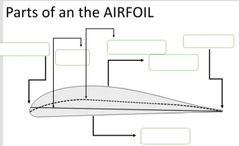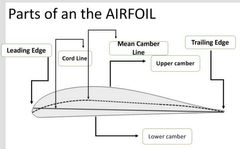![]()
![]()
![]()
Use LEFT and RIGHT arrow keys to navigate between flashcards;
Use UP and DOWN arrow keys to flip the card;
H to show hint;
A reads text to speech;
92 Cards in this Set
- Front
- Back
|
Is an envelope of air that surround the Earth and rests upon its surface |
Atmosphere |
|
|
It has mass,weight and indefinite shape |
Atmosphere |
|
|
The atmosphere is composed of ____ percent nitrogen, ___percent oxygen and __percent other gases such as ___ or ____ |
78,21,1, argon or helium |
|
|
The heavier elements such as ____ settle to the surface of the Earth while the lighter elements are lifted up to the region of higher altitude |
Oxygen |
|
|
Most of the atmosphere's oxygen is contained below _____feet altitude |
35,000 ft |
|
|
Spacecraft can be located at |
400 km in exosphere |
|
|
Satellites can be found at the |
800km in exosphere |
|
|
The supersonic planes can be found at the |
40km in stratopause |
|
|
Commercial aircrafts can be found at |
10km in tropopause |
|
|
Small aircrafts can be found at |
4km in troposphere |
|
|
1km is equals to _____ft |
3280.84 |
|
|
Take on the shape of their containers |
Fluid |
|
|
Generally do not resist deformation when even the smallest stress is applied or they resist it only slightly |
Fluids |
|
|
Have the ability to flow |
Fluid |
|
|
Same as the gasses, like the may be considered also as |
Fluids but in the form of gas |
|
|
Just as a liquid flows and fills a container, air will |
Expand to fill the available volume of its container |
|
|
What is fluid? |
They have the ability to flow. They do not resist deformation only slightly. Take on the shape of their containers |
|
|
Is the property of a fluid that causes it to resist flowing |
Viscosity |
|
|
How we will determine how much a fluid can resists flow? |
It is the way of fluid tend to adhere, or stick to each other |
|
|
High viscosity fluids are |
Thick and resist flow |
|
|
Low viscosity fluids are |
Thin and flow easily |
|
|
How will fluid relate to the air? |
Air has a low viscosity and flows easily. All fluids are viscous and have a resistance to flow |
|
|
It is the resistance that one surface or object encounters when moving over another |
Friction |
|
|
Exists between any two materials thay contact each other |
Friction |
|
|
The surface roughness causes |
Resistance and slows the velocity of the air flowing |
|
|
is a primary control surface that control the aircraft around its longitudinal. Controls by a control stick |
aileron |
|
|
Is a control surface that control the aircraft movement on its lateral axis. |
Elevator |
|
|
Is a control surface that control the aircraft movement on its vertical axis. |
Rudder |
|
|
Axes of an aircraft |
Longitudinal Lateral Vertical |
|
|
Imaginary line that extend from nose to tail of an aircraft. |
Longitudinal axis |
|
|
Imaginary line that extend from wing tip to wing tip of an aircraft. |
Lateral axis |
|
|
Imaginary line that extend from center of an aircraft to center of gravity of an aircraft. |
Vertical axis |
|
|
Aircraft Movement |
Yaw Roll Pitch |
|
|
Movement of an aircraft on its vertical Axis. |
Yaw |
|
|
Movement of an aircraft on its longitudinal Axis. |
Roll |
|
|
Movement of an aircraft on its lateral Axis. |
Pitch |
|
|
Secondary Flight Control Surfaces |
Flaps Elevator trims Trim tabs |
|
|
used for landing & take off to increase lift and drag. |
Flaps |
|
|
Used to balance condition in flight |
Elevator trims |
|
|
An auxiliary flight control surface that enables a pilot to make adjustments during flight to correct any unbalanced. |
Trim tabs |
|
|
Is the force applied in a perpendicular direction to the surface of an object |
Pressure |
|
|
inlet of the atmospheric pressure. |
Static port |
|
|
inlet of the atmospheric pressure. |
Static port |
|
|
measures the speed of the aircraft vertically |
Vertical speed indicator |
|
|
pressure is measured in |
pounds of force exerted per square inch of an object, or PSI |
|
|
pressure is measured in |
pounds of force exerted per square inch of an object, or PSI |
|
|
If the pressure on one surface of the object becomes less than the pressure exerted on the other surfaces, the object will |
move in the direction of the lower pressure. |
|
|
Is one of the basic factors in weather changes, helps to lift an aircraft, and actuates some of the important flight instruments. |
Atmospheric pressure |
|
|
Pilots main concern |
Atmospheric pressure |
|
|
Why pilots main concern is atmospheric pressure? |
Because the atmospheric pressure is one of the basic factors in weather changes, helps to lift an aircraft, and actuates some of the important flight instruments. |
|
|
Important flight instruments |
altimeter airspeed indicator vertical speed indicator manifold pressure gauge |
|
|
Since air is a fluid substance, this force is exerted equally in all directions. Its effect on bodies within the air is called |
Pressure |
|
|
Under standard conditions at sea level, the average pressure exerted by the weight of the atmosphere is approximately |
14.70 pounds per square inch (psi) of surface, or 1,013.2 millibars (mb). |
|
|
the higher the altitude, the ____ air there is above. |
Less |
|
|
The pressure of the atmosphere varies with |
Time and location |
|
|
The standard atmosphere at sea level is a surface temperature of _____ and a surface pressure of ________. [Figure 4-2] |
59 °F or 15 °C , 29.92 inches of mercury ("Hg) or 1,013.2 mb |
|
|
standard atmosphere at sea level is a surface temperature of |
59°F or 15°C |
|
|
The standard atmosphere on a surface pressure of |
29.92 inches of mercury ("Hg) or 1,013.2 mb. |
|
|
The International Civil Aviation Organization (ICAO) has established this as a worldwide standard, and it is often referred to as
|
International Standard Atmosphere (ISA) or ICAO Standard Atmosphere.
|
|
|
ICAO means |
International Civil Aviation Organization |
|
|
is when pressure decreases at a rate of approximately 1 "Hg per 1,000 feet of altitude gain to 10,000 feet. |
Standard pressure lapse rate |
|
|
Newtons First Law of Motion (Inertia) |
Every object persists in its state of rest or uniform motion in a straight line unless it is compelled to change that state by forces impressed on it.” |
|
|
Second Newtons Law of Motion (Law of Acceleration) |
“Force is equal to the change in momentum per change in time. For a constant mass, force equals mass times acceleration.” |
|
|
Newton’s Third Law: law of interaction
|
“For every action, there is an equal and opposite reaction.” |
|
|
Bernoulli’s Principle states that |
as the velocity of a moving fluid (liquid or gas) increases, the pressure within the fluid decreases. |
|
|
Bernoulli’s Principle of Differential Pressure was discovered by |
Daniel Bernoulli |
|
|
Daniel Bernoulli explained |
how the pressure of a moving fluid (liquid or gas) varies with its speed of motion |
|
|
This principle explains what happens to air passing over the curved top of the airplane wing |
Bernoulli's Principle |
|
|
A practical application of Bernoulli’s Principle is the |
venturi tube |
|
|
are large tubes with air moving inside . |
Wind tunnels |
|
|
are used to copy the actions of an object in flight. Researchers used it to learn more about how an aircraft will fly. |
Wind tunnel |
|
|
It is a design to provide a desired reaction force when in motion relative to the surrounding air |
Airfoil |
|
|
And it is design to produce lift |
Airfoil |
|
|
Airfoil has different curvatures or we call it |
Cambers |
|

|

|
|
|
is the upper and lower surfaces of the airfoil. |
Camber |
|
|
The two extremities of airfoil is the |
leading edge and the trailing edge |
|
|
The rounded end, which faces forward in flight |
leading edge |
|
|
is quite narrow and tapered. |
Trailing edge |
|
|
it is straight line drawn through the profile connecting the extremities of the leading and trailing edges |
Cord Line |
|
|
it is a reference line from the leading edge to the trailing edge that is equidistant at all points from the upper and lower surfaces. |
Mean Camber Line |
|
|
Flat bottom airfoil means |
Good lift/Low drag |
|
|
Under camber airfoil means |
High lift/ High drag |
|
|
Flat (No airfoil) |
Poor lift/ no drag |
|
|
Symmetrical airfoil |
Good lift/Low drag |
|
|
Airfoil designs |
1. Early airfoil 2. Later airfoil 3. Clark "Y" airfoil (subsonic) 4. Laminar flow airfoil (subsonic) 5. Circular arc airfoil (supersonic) 6. Double wedge airfoil (supersonic) |
|
|
An airfoil is constructed in such a way that its shape takes advantage of the air’s response to certain physical laws. This develops two actions from the air mass: |
a positive pressure lifting action from the air mass below the wing, and a negative pressure lifting action from lowered pressure above the wing. |
|
|
When the air speeds up, the pressure also_____ . Past the constriction, the airflow slows and the pressure ____ |
decreases , increases |
|
|
Applying Bernoulli’s Principle of Pressure, the increase in the speed of the air across the top of an airfoil produces a ____ in pressure. |
drop |
|
|
The downward backward flow from the top surface of an airfoil creates a |
Downwash |
|
|
This downwash meets the flow from |
the bottom of the airfoil at the trailing edge. |
|
|
Applying Newton’s third law, the reaction of this downward backward flow results in an _______ force on the airfoil. |
upward forward |

